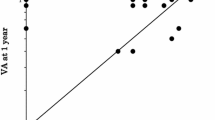Abstract
Purpose
To analyse the rate of clinical recurrences in Brazilian patients with Vogt–Koyanagi–Harada (VKH) disease after early high-dose corticosteroid treatment.
Methods
Retrospective study including patients treated with early high-dose corticosteroids (prednisone, 1–1.5 mg/kg/day, or 3-day 1 g methylprednisolone pulsetherapy) within 1 month from disease onset followed by slow taper (at least 6 months). Patients with a minimum 12-month follow-up were subdivided based on the presence of disease recurrence or persistence after 6 months from initial presentation into: acute–resolved (AR, no recurrences), chronic–recurrent (CR), and chronic–recurrent with subretinal fibrosis (SRF). Recurrences were defined as the presence of clinical and/or fluorescein angiography findings.
Results
Twenty-nine patients (58 eyes) with a median follow-up of 65 months were included. Six (21 %), 11 (38 %) and 12 (41 %) patients were allocated to AR, CR, and SRF groups respectively. Though having received treatment within 1 month of onset, median time to initial treatment differed among groups (11, 15, and 25 days, in AR, CR, and SRF groups respectively). Intensity of immunosuppression, cataract development, and longer time to achieve logMAR visual acuity ≤0.8 differed significantly among the groups, being more severe in SRF group. HLA-DRB1*0405 allele followed the same trend, though not reaching significance (0.5 in AR group, 0.6 in CR, and 0.8 in SRF).
Conclusion
VKH disease in Brazilian patients evolved to chronic–recurrent disease in 79 % of cases; 38 % developed subretinal fibrosis, in spite of similar initial treatment regimens. Time to initiate treatment influenced outcomes.


Similar content being viewed by others
References
Rubsamen PE, Gass JE (1991) Vogt–Koyanagi–Harada syndrome clinical course, therapy and long-term visual outcome. Arch Ophthalmol 11:682–687
Moorthy RS, Inomata H, Rao NA (1995) Major review Vogt–Koyanagi–Harada syndrome. Surv Ophthalmol 39:265–292
Al-Kharashi AS, Aldibhi H, Al-Fraykh H, Kangave D, Abu El-Asrar AM (2007) Prognostic factors in Vogt–Koyanagi–Harada disease. Int Ophthalmol 27:201–210
Chee S-P, Jap A, Bacsal K (2009) Prognostic factors of Vogt–Koyanagi–Harada disease in Singapore. Am J Ophthalmol 147:154–161
Abu El-Asrar AM, Al Tamimi M, Hemachandran S, Al-Mezaine HS, Al-Muammar A, Kangave D (2013) Prognostic factors for clinical outcomes in patients with Vogt–Koyanagi–Harada disease treated with high-dose corticosteroids. Acta Ophthalmol 91:e486–e493
da Silva FTBGC, Damico FM, Marin ML, Goldberg AC, Hirata CE, Olivalves E, Yamamoto JH (2009) Revised diagnostic criteria for Vogt–Koyanagi–Harada disease: considerations on the different disease categories. Am J Ophthalmol 147:339.e5–345.e5
Chee S-P, Jap A, Bacsal K (2007) Spectrum of Vogt–Koyanagi–Harada disease in Singapore. Int Ophthalmol 27:137–142
Tugal-Tutkun I, Ozyazgan Y, Akova Y, Sullu Y, Akyol N, Soylu M, Kazokoglu H (2007) The spectrum of Vogt–Koyanagi–Harada disease in Turkey: VKH in Turkey. Int Ophthalmol 27:117–123
Read RW, Holland GN, Rao NA, Tabbara KF, Ohno S, Arellanes-garcia L, Pivetti-pezzi P, Tessler HH, Usui M (2001) Revised diagnostic criteria for Vogt–Koyanagi–Harada disease. Am J Ophthalmol 131:647–652
Jabs DA, Nussenblatt RB, Rosenbaum JT, Standardization of Uveitis Nomenclature (SUN) Working Group (2005) Standardization of uveitis nomenclature for reporting clinical data. Results of the first international workshop. Am J Ophthalmol 140:509–516
Kuo IC, Rechdouni A, Rao NA, Johnston RH, Margolis TP, Cunningham ET (2000) Subretinal fibrosis in patients with Vogt–Koyanagi–Harada disease. Ophthalmology 107:1721–1728
Bignon JD, Fernandez-Vina MA (1997) Protocols of the 12th international histocompatibility workshop for typing of HLA class II alleles by DNA amplification by the polymerase chain reaction (PCR) and hybridization with sequence specific oligonucleotide probes (SSOP). In: Charron D (ed) Genetic diversity of HLA, functional and medical implications. EDK, Paris, pp 584–595
Lertsumitkul S, Whitcup SM, Nussenblatt RB, Chan CC (1999) Subretinal fibrosis and choroidal neovascularization in Vogt–Koyanagi–Harada syndrome. Graefes Arch Clin Exp Ophthalmol 237:1039–1045
da Silva FT, Hirata CE, Olivalves E, Oyamada MK, Yamamoto JH (2009) Fundus-based and electroretinographic strategies for stratification of late-stage Vogt–Koyanagi–Harada disease patients. Am J Ophthalmol 148:939.e3–945.e3
Gass JDM, Margo CE, Levy MH (1996) Progressive subretinal fibrosis and blindness in patients with multifocal granulomatous chorioretinitis. Am J Ophthalmol 122:76–85
Sternberg P Jr, Machemer R (1984) Subretinal proliferation. Am J Ophthalmol 98:456–462
Green W, Enger C (2005) Age related macular degeneration histopathologic studies. The 1992 Lorenz E. Zimmerman Lecture. Retina 25:1519–1535
Goldberg AC, Yamamoto JH, ChiarellaJ M, Marin ML, Sibinelli M, Neufeld R, Hirata CE, Olivalves E, Kalil J (1998) HLA-DRB1*0405 is the predominant allele in Brazilian patients with Vogt–Koyanagi–Harada disease. Hum Immunol 59:183–188
Damico FM, Cunha-Neto E, Goldberg AC, Iwai LK, Marin ML, Hammer J, Kalil J, Yamamoto JH (2005) T-cell recognition and cytokine profile induced by melanocyte epitopes in patients with HLA-DRB1*0405-positive and -negative Vogt–Koyanagi–Harada uveitis. Invest Ophthalmol Vis Sci 46:2465–2471
Islam SM, Numaga J, Matsuki K, Fujino Y, Maeda H, Masuda K (1994) Influence of HLA-DRB1 gene variation on the clinical course of Vogt–Koyanagi–Harada disease. Invest Ophthalmol Vis Sci 35:752–756
Kim MH, Seong MC, Kwak NH, Yoo JS, Huh W, Kim TG, Han H (2000) Association of HLA with Vogt–Koyanagi–Harada syndrome in Koreans. Am J Ophthalmol 129:173–177
Acknowledgments
The authors thank Dr Rogério Ruscitto do Prado, Statistics Division, Department of Preventive Medicine, Faculdade de Medicina da Universidade de São Paulo, São Paulo, SP, Brazil, for his assistance with statistical analysis.
Funding
This work was supported in part by Fundação de Amparo à Pesquisa do Estado de São Paulo grant number #11/50936-7/scholarship #07/57154-9.
Conflict of interest statement
All authors certify that they have NO affiliations with or involvement in any organization or entity with any financial interest (such as honoraria; educational grants; participation in speakers’ bureaus; membership, employment, consultancies, stock ownership, or other equity interest; and expert testimony or patent-licensing arrangements), or non-financial interest (such as personal or professional relationships, affiliations, knowledge or beliefs) in the subject matter or materials discussed in this manuscript
Financial disclosure
The authors have no financial interest in the products mentioned in the manuscript.
Author information
Authors and Affiliations
Corresponding author
Rights and permissions
About this article
Cite this article
Sakata, V.M., da Silva, F.T., Hirata, C.E. et al. High rate of clinical recurrence in patients with Vogt–Koyanagi–Harada disease treated with early high-dose corticosteroids. Graefes Arch Clin Exp Ophthalmol 253, 785–790 (2015). https://doi.org/10.1007/s00417-014-2904-z
Received:
Revised:
Accepted:
Published:
Issue Date:
DOI: https://doi.org/10.1007/s00417-014-2904-z




